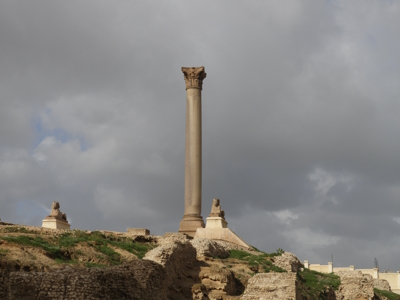Alexandria

Alexandria, ancient remains and the new library is part of the Tentative list of Egypt in order to qualify for inclusion in the World Heritage List.
Alexandria, founded in 331 BC, was an important centre of Hellenistic civilization and remained the capital of Ptolemaic Egypt and Roman and Byzantine Egypt. Very little of the ancient city has survived into the present day, however "Pompey's Pillar", a Roman triumphal column, is still standing. The modern Bibliotheca Alexandrina (2002) is based on reviving the ancient Library of Alexandria, which was one of the largest and most significant libraries of the ancient world.
Map of Alexandria
Load mapThe coordinates shown for all tentative sites were produced as a community effort. They are not official and may change on inscription.
Community Reviews
Wojciech Fedoruk

Place visited in February 2023. From this proposal, me and my family visited two components – ‘Huge monuments and structures’ and ‘Ancient necropolises’ At the beginning we visited Pompey's Pillar with its surroundings (ruins of Serapeion). The pillar is gigantic, measuring almost 27 meters and stands out even now outside the buildings in the city center. In the area there are numerous statues of Greek and Roman provenance.
The number one of our visit to Alexandria was certainly the Catacombs of Kom El Shoqafa – a huge underground cemetery with beautifully decorated tombs, placed on the list of the Seven Wonders of the Middle Ages. The catacombs are multi-level and contain many side corridors. The necropolis consists of a series of tombs tunnelled in 2nd century AD and used until 4th century. They represent a mix of Egyptian, Greek and Roman traditions and styles.
Apart from these sights, Alexandria did not make a good impression on us. We wanted to wander around the city and see the Biblioteca Alexandrina building, but after a long stand in the crap in giant traffic jams, we didn't feel like it. By the way – I don't know why Egypt put a modern New Library building as part of the proposal – it does not fit at all with the other ancient monuments and when assessed by ICOMOS (if it ever happens) it is unlikely to hold.
John booth

Alexandria's long and colourful history is what makes it such an interesting and diverse city. The remains from the Greco-Roman era are quite evident in the underground necropolises, the Roman theatre and nearby excavations, and artifacts brought from beneath the harbour also on display. The plan of the city was changed radically by an earthquake which toppled the Pharos lighthouse and submerged much of the city creating the harbour. The Ottomans used the stone from the lighthouse to build much of the Qait Bey citadel. Modern architecture is represented by the palaces built for King Farouk in the Montazah Gardens and the ultra-modern library complex completed in 2002.
Community Likes
Site Info
- Full Name
- Alexandria, ancient remains and the new library
- Country
- Egypt
- Added
- 2003
- Type
- Cultural
- Categories
- Archaeological site - Ancient Greece Structure - Science and Education
- Link
- By ID
Site History
2003 Added to Tentative List
Site Links
Locations
The site has 4 locations
Visitors
78 Community Members have visited.